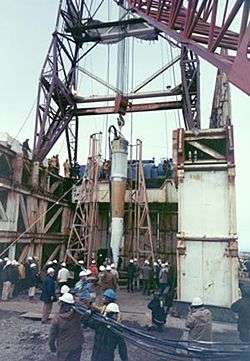Cannikin

Cannikin was an underground nuclear weapons test performed on November 6, 1971, on Amchitka island, Alaska, by the United States Atomic Energy Commission.[1] The experiment, part of the Operation Grommet nuclear test series, tested the warhead design for the LIM-49 Spartan anti-ballistic missile.[2] With an explosive yield of almost 5-megatons TNT equivalent, the test was the largest underground explosion ever detonated by the United States.[3]
Prior to the main five megaton test in 1971, a one megaton test took place on the island on October 2, 1969 for calibration purposes, and to ensure the subsequent Cannikin test could be contained.[3] This test, Milrow, was included in the Operation Mandrel nuclear test series.
The Cannikin test faced considerable opposition on environmental grounds. The campaigning environmental organization Greenpeace grew out of efforts to oppose the test.
Siting
The Cannikin test was too large to be conducted safely in Nevada.[3] Amchitka had been considered in the 1950s as a potential nuclear test site, but had been deemed unsuitable at that time.[4] In 1965, a single nuclear test, 'Long Shot', was carried out on the island for the purposes of seismic test detection development, under program Vela Uniform.
Preparation
Preparation for the test took place over five years and involved hundreds of staff from the Lawrence Radiation Laboratory, later the Lawrence Livermore National Laboratory. Drilling for the shaft for the 'Milrow' test began in March 1967, with drilling for the Cannikin test commencing in August 1967.[5]
To perform the test, 400 tons of equipment was placed in a shaft 6,150 feet deep and 90 inches wide. Test support equipment was designed to survive a ground upheaval of 15 feet at test time.[2]
Chairman of the Atomic Energy Commission, James R. Schlesinger, brought his wife and two daughters to Amchitka for the test to emphasize the safety of the test.[6]
Opposition
Both the 1969 calibration test and Cannikin itself attracted protest. Because of the 1964 Alaska earthquake, the plans raised concerns that tests might trigger earthquakes and cause a tsunami. A 1969 demonstration of 7,000 [7] people blocked a major U.S.-Canada border crossing in British Columbia, carrying signs reading "Don't Make A Wave. It's Your Fault If Our Fault Goes".[8] Further demonstrations occurred at Canada–US border crossings in Ontario and Quebec.[9] The Canadian Don't Make a Wave Committee founded that year attempted to halt further testing on the island. With the intention of sailing to Amchitka to protest the 1971 test, the committee chartered a ship it renamed Greenpeace. The ship was turned back by the U.S. Coast Guard. However, under this name, the organization created for the protest continued to exist as the campaigning environmental organization Greenpeace.
In July 1971, the anti-nuclear Committee for Nuclear Responsibility filed suit against the Atomic Energy Commission, asking the court to stop the test.[10] The suit was unsuccessful, with the Supreme Court denying the injunction by 4 votes to 3.[11]
References
- ↑ Mark Nuttall (2004). Encyclopedia of the Arctic. Routledge. ISBN 1579584365.
the AEC instituted an extensive bioenvironmental program on Amchitka, and within a few years had completed Project Milrow, Project Long Shot, and Project Cannikin
- 1 2 "Accomplishments in the 1970s: Lawrence Livermore National Laboratory". Archived from the original on 2005-02-17. Retrieved 2006-10-09.
- 1 2 3 The Containment of underground nuclear explosions. 1989.
This test, by far the highest-yield underground test ever conducted by the United States, was too large to be safely conducted in Nevada
- ↑ Giblin, Michael O.; David C. Stahl; Jodi A. Bechtel. Surface remediation in the Aleutian Islands: A case study of Amchitka Island, Alaska (PDF). WM '02 Conference, Tucson AZ, February 24–28, 2002. Retrieved 2006-10-07.
- ↑ "Energy Employees Occupational Illness Compensation Program: Facility List" (PDF).
For the Milrow detonation, drilling began March 9, 1967
- ↑ Jim Clarke (June 29, 1997). "Scientists Hunt for H-Bomb Fallout". The Los Angeles Times.
James Schlesinger, then AEC chairman, brought his wife and two daughters to Amchitka for the Cannikin blast
- ↑ Protests fail to stop Nuclear Test countdown, The Free-Lance Star - Oct 2, 1969, Accessed via Google News Archive October 4, 2009.
- ↑ Brown, Michael; May, John (1991). The Greenpeace Story (2nd ed.). London: Dorling Kindersley. ISBN 0-86318-691-2.
- ↑ Alaska is Braced for Atomic Shock, St. Petersburg Times - Oct 2, 1969. Accessed via Google News Archive October 4, 2009. Has a subtitle - Demonstrators picket US Embassy in Ottawa.
- ↑ "Round 2 at Amchitka". U.S. TIME. New York City. 1971-07-17. Archived from the original on 2008-12-21. Retrieved 2006-10-09.
- ↑ "The Amchitka Bomb Goes Off". TIME. 1971-11-15. Retrieved 2006-10-09.
Coordinates: 51°28′13.20″N 179°6′40.75″E / 51.4703333°N 179.1113194°E